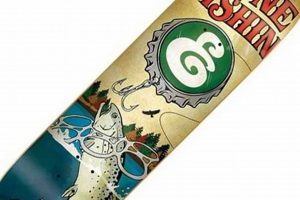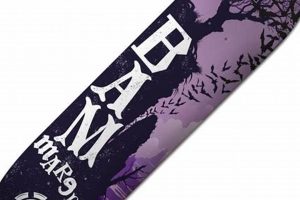A foundational component in skateboarding, the platform provides the surface upon which a rider stands, performs tricks, and navigates terrain. Constructed primarily from multiple layers of laminated maple wood, this essential piece of equipment is engineered to withstand considerable impact and stress. For example, variations in width, length, and concave affect stability, maneuverability, and overall rider experience.
Its selection is pivotal for both novice and experienced skateboarders due to its direct influence on performance and control. Historically, advancements in construction materials and design have continuously improved durability and responsiveness. A well-suited platform enhances a rider’s ability to execute complex maneuvers and progress in the sport. Furthermore, the graphic applied to its underside often serves as a form of personal expression and identification within the skateboarding community.
The subsequent sections will delve into specific attributes, design considerations, material science, and the evolving landscape of these important components within the skateboarding industry. These elements highlight the critical role they play in the functionality and progression of the sport.
Guidance for Optimal Selection
Selecting the correct platform is crucial for maximizing performance and ensuring rider safety. The following guidelines offer insight into key considerations during the selection process.
Tip 1: Assess Skill Level: Beginner skateboarders generally benefit from a wider surface. This increased width provides greater stability and control, facilitating the learning process. Experienced riders, however, may prefer a narrower platform for enhanced maneuverability.
Tip 2: Consider Riding Style: Different skateboarding disciplines, such as street, park, or vert, require specific platform characteristics. Street skating often involves a smaller size for quicker response, while vert utilizes larger platforms for stability at higher speeds.
Tip 3: Evaluate Concave: The curvature across the width significantly affects foot placement and board feel. A steeper concave provides a more pronounced pocket for foot placement, leading to improved control during flip tricks. A mellow concave offers a flatter, more forgiving surface.
Tip 4: Inspect Material Quality: The construction involves multiple plies of maple wood. Examine the plies for consistent thickness and proper bonding. Higher-quality construction translates to increased durability and resistance to warping or delamination.
Tip 5: Account for Size and Weight: The overall dimensions and weight influence the board’s responsiveness and suitability for specific body types. Smaller riders may prefer a lighter platform, while larger riders may require a wider and more robust option.
Tip 6: Check the Graphic: While aesthetics are subjective, a quality graphic indicates attention to detail in the manufacturing process. Ensure the graphic is applied evenly and is resistant to chipping or fading.
Effective platform selection relies on understanding individual needs and preferences in relation to technical specifications. Careful consideration of these factors ensures a more enjoyable and successful skateboarding experience.
The concluding section will summarize the essential characteristics and provide a forward-looking perspective on future innovations and emerging trends.
1. Construction Materials
The selection and arrangement of materials directly influence the performance, durability, and overall quality of a skateboard platform. These construction choices determine its resistance to stress, its responsiveness, and its lifespan under rigorous use.
- Maple Wood Laminates
The primary construction material is typically Canadian maple, renowned for its strength and flexibility. Multiple thin veneers of maple are laminated together with adhesive, creating a composite structure. The number of plies, usually seven, contributes significantly to the platform’s strength and ability to withstand impact. Variations in wood quality and lamination techniques impact the longevity of the board.
- Adhesives
The adhesives used to bond the maple plies are crucial for structural integrity. High-quality epoxy resins or similar bonding agents are employed to create a durable and water-resistant bond. Improper adhesive selection or application can lead to delamination, compromising the integrity and reducing the platform’s lifespan. The adhesive must maintain its properties under repeated stress and temperature fluctuations.
- Reinforcement Materials
Some incorporate additional materials, such as fiberglass or carbon fiber, to enhance strength and stiffness. These reinforcements are strategically placed within the wood laminate structure to increase resistance to warping and breakage. The integration of reinforcement materials can alter the flex characteristics and pop of the platform, tailoring it to specific riding styles.
- Finish and Sealants
The final layer applied protects the wood from moisture and abrasion. Polyurethane coatings or similar sealants are commonly used to provide a durable, water-resistant surface. The finish also affects the grip and feel of the surface. Imperfect sealing could lead to water absorption that could affect the structure.
The interplay between these components dictates the overall performance and durability. Optimized material selection and meticulous construction techniques are paramount in producing a high-quality skateboard platform capable of enduring the demands of modern skateboarding.
2. Shape and Concave
The contour of the upper surface significantly impacts a skateboarder’s control and trick execution. Variations in design, particularly concerning the degree and type of curvature, directly affect foot placement, board feel, and the ability to perform technical maneuvers on a skateboard platform.
- Concave Depth and Type
The depth of the concave, measured as the curvature across the width, influences foot lock-in. A steeper concave provides a more pronounced pocket, enabling enhanced grip during flip tricks. Variations such as mellow, medium, and steep concave cater to different preferences. For example, a skater executing kickflips might favor a steeper concave, while a cruiser might prefer a mellow concave for foot comfort during long rides.
- Nose and Tail Shape
The shape of the nose and tail, typically symmetrical or near-symmetrical, contributes to the board’s pop and handling. Variations in nose and tail angles impact the board’s responsiveness when initiating tricks. Square tails can provide a more consistent pop, while rounded noses offer a smoother ride and enhanced stability for certain maneuvers. Their design directly influences the ability to generate lift and control during ollies and other aerial tricks.
- Width and Length Proportions
The dimensions, including width and length, affect stability and maneuverability. A wider platform generally offers greater stability, beneficial for beginners or skaters focusing on vert skating. A narrower platform allows for quicker turning and responsiveness, preferred by street skaters. The ratio of width to length also impacts the board’s responsiveness to foot movements and weight distribution.
- Edge Profile
The profile of the board’s edges, whether rounded or squared, influences the board’s feel and interaction with surfaces. Rounded edges can provide a smoother ride and prevent the board from catching during grinds. Squared edges, on the other hand, offer a more direct connection and control. The design of the edge profile directly impacts stability and handling characteristics.
The synergy between shape and concave features significantly enhances the riding experience, allowing for precise control and personalized performance. The choice of shape and concave is often a matter of individual preference, tailored to specific riding styles and skill levels. These are critical design elements impacting maneuverability and overall performance.
3. Size variations
The dimensions of a skateboard platformwidth, length, and wheelbasedirectly influence its stability, maneuverability, and overall suitability for different riding styles and rider sizes. Specifically, size variations impact the performance characteristics of any platform, dictating its responsiveness and the rider’s ability to control it. Variations in width, for example, range from approximately 7.5 inches to over 9 inches. A narrower platform facilitates quicker turning, often favored by street skaters, while a wider platform provides increased stability, which benefits vert skaters or larger individuals.
Length and wheelbase also play critical roles. A longer wheelbase, the distance between the inner mounting holes for the trucks, enhances stability at higher speeds. In contrast, a shorter wheelbase allows for tighter turns. Examples include street skaters favoring smaller platforms for enhanced agility while park skaters prefer a larger platform for stability during grinds and aerial maneuvers. Recognizing these variations is important for riders seeking to optimize their performance and board control. For instance, a rider with larger feet might require a wider platform to ensure comfortable foot placement and proper balance.
In summary, size variations are an integral component that determines the overall functionality. Understanding these relationships enables skaters to make informed decisions. The dimensional attributes should align with their style and physical build. Challenges in selecting the proper dimensions can result in compromised performance or increased risk of injury. The integration of advanced materials and construction methods continues to shape platform design, contributing to enhanced durability and customized performance characteristics.
4. Graphic design
Visual representation on a skateboard platform serves as a significant marketing and branding tool. Furthermore, it offers a medium for artistic expression and personal identification within the skateboarding community. The graphic designs on this platform are not merely aesthetic elements; they contribute to brand recognition, product differentiation, and consumer appeal.
- Brand Identity and Recognition
Graphic designs reinforce brand identity through the consistent use of logos, color schemes, and thematic imagery. A clearly defined visual identity builds brand recognition. For example, repeated use of a specific logo or character on various platforms creates a familiar association. This consistent branding strategy strengthens consumer recall and loyalty.
- Artistic Expression and Collaboration
Skateboard platforms often feature artwork created by professional artists, illustrators, and designers. Collaborative projects between companies and artists produce unique, limited-edition designs that enhance the platform’s collectibility. These designs can range from abstract patterns to detailed illustrations, providing a visual outlet for creative expression.
- Product Differentiation and Market Appeal
Distinctive graphics distinguish a product from competitors. A compelling visual presentation increases its market appeal. Original and innovative designs attract consumers seeking to express their individuality through their equipment. Limited releases featuring exclusive designs generate excitement and demand within the skateboarding market.
- Cultural Significance and Social Commentary
Graphics have been used to convey messages and narratives, reflecting current social trends or political stances. These designs contribute to the ongoing conversation and social commentary within the skateboarding culture. By using graphics as a form of expression, they can promote awareness and engagement.
The integration of effective visual elements enhances market presence, reflects brand values, and fosters a connection with consumers. Graphic design is an influential component in shaping the perception and appeal of this specific skateboard platform.
5. Durability rating
A critical factor in evaluating the longevity and performance, the assessment provides a standardized measure of its ability to withstand stress, impact, and wear. This metric influences purchasing decisions, reflecting its capacity to endure common skateboarding activities.
- Material Composition
The type and quality of materials significantly affect the overall durability rating. High-grade Canadian maple, known for its strength and flexibility, is a common material. A higher durability rating indicates a greater ability to resist fractures and delamination under repeated stress. Lower-quality materials result in a reduced rating. For example, a seven-ply maple construction generally receives a higher rating than a six-ply due to its increased structural integrity.
- Construction Techniques
Manufacturing processes play a crucial role in determining its durability. Techniques such as resin pressing and heat transfer methods enhance the bond between the maple plies. A high durability rating suggests meticulous construction methods that minimize the occurrence of weak spots and structural vulnerabilities. Advanced construction techniques ensure a more robust, longer-lasting platform.
- Impact Resistance Testing
Standardized tests, such as drop tests and pressure tests, assess its ability to withstand impact forces. Durability ratings derived from these tests reflect its capacity to absorb shock without sustaining damage. Platforms that exhibit minimal deformation or breakage under high-impact conditions receive higher ratings. These tests simulate real-world scenarios, providing an objective measure of strength.
- Environmental Factors
Resistance to environmental factors, such as moisture and temperature fluctuations, influences long-term performance. A high durability rating indicates a degree of protection against warping or degradation due to exposure. Sealants and finishes applied during manufacturing improve water resistance, contributing to the overall rating. Variations in environmental conditions can significantly impact the lifespan, underscoring the importance of protective measures.
The durability rating serves as a composite assessment, reflecting the interplay between material quality, construction methods, impact resistance, and environmental protection. This rating informs skateboarders about the expected lifespan and performance characteristics. The rating ensures they can make informed decisions aligned with their needs.
6. Performance Characteristics
The inherent traits dictating how the equipment responds to rider input and environmental conditions. For skateboarding platforms, these characteristics determine the degree of control, stability, and responsiveness exhibited during various maneuvers. The composition, design, and manufacturing of the skateboard platforms each affect how they execute.
- Flexibility and Pop
Flex, referring to its capacity to bend under pressure, influences the board’s responsiveness. A more flexible option can absorb impact. A stiffer choice delivers more direct energy transfer. Pop, generated by snapping the tail or nose against the ground, determines lift during ollies and other aerial tricks. Maple wood veneers are common. These veneers are laminated with adhesives to regulate the flexibility and pop. This regulation optimizes the platform for street or park skating.
- Weight and Balance
The distribution significantly impacts maneuverability. Lightweight enables quicker movements. Balanced distribution improves stability. An imbalanced platform can lead to unpredictable behavior. For instance, a nose-heavy platform can hinder flip tricks, while a tail-heavy one can make it difficult to maintain balance during manuals. The choice of wood and the presence of reinforcement materials also influence the platforms final mass.
- Impact Resistance and Durability
Skateboarders subject them to considerable stress. High-impact landings can cause fractures or delamination. Enhanced resistance to impact, determined by material composition and construction techniques, dictates its longevity. Resin pressing strengthens the bond between the maple plies, thus improving its resistance to warping and breakage. The higher the resistance, the longer the skateboard endures.
- Surface Grip and Control
The deck tape applied to its surface determines the degree of grip available to the rider. A high-quality grip tape offers enhanced control and stability, especially during technical maneuvers. Variations in texture and material composition affect the grips effectiveness in diverse conditions, such as wet or dry environments. Optimal grip promotes confidence and prevents slippage.
The interplay between these factors dictates the overall suitability. By understanding and optimizing these characteristics, skateboarders can achieve enhanced performance and a more rewarding riding experience. Therefore, these characteristics dictate its functionality and ability to meet the demands.
Frequently Asked Questions
The following questions address common inquiries regarding these essential components in skateboarding, providing clarity on their design, functionality, and maintenance.
Question 1: What factors contribute to the structural integrity?
The primary determinant is the wood used. High-quality Canadian maple, arranged in multiple cross-laminated plies, provides optimal strength. Adhesive selection and application techniques during manufacturing significantly affect its resistance to delamination. Reinforcement materials, like fiberglass, may further enhance resilience.
Question 2: How does concave depth impact riding performance?
Concave depth influences foot placement and board feel. A steeper concave provides enhanced grip during flip tricks, while a mellow concave offers a more forgiving surface. The concave should correspond to the rider’s technical abilities and riding style.
Question 3: What is the recommended size for beginner skateboarders?
Beginners typically benefit from a wider surface, generally between 8.0 and 8.5 inches. A wider platform offers increased stability and control, facilitating the learning of fundamental skills. As skills progress, riders may transition to narrower options.
Question 4: How can platform graphics affect value?
Graphics significantly contribute to market presence and brand recognition. Artist collaborations and limited-edition designs may increase collectibility and resale value. However, the functional aspects, such as structural integrity, are paramount.
Question 5: How does climate affect maintenance?
Exposure to moisture and extreme temperatures can damage the wood. Proper storage in a cool, dry environment prevents warping and delamination. Regularly inspect for signs of water damage and apply protective sealants to prolong lifespan.
Question 6: Is there a method to assess durability?
Examine the number of plies and the quality of the maple wood. Assess the lamination for consistent thickness and proper bonding. Brands with established reputations for quality typically offer more reliable products. Impact-resistance tests will objectively measure strength.
Careful evaluation of these factors ensures an informed purchasing decision and optimal performance.
The subsequent section will conclude the discussion, summarizing key insights and future trends.
Concluding Summary
This exploration has detailed essential aspects of the darkstar skate deck, encompassing material composition, shape variations, graphic design considerations, durability assessment, and performance characteristics. These elements collectively influence functionality, and suitability. A proper understanding facilitates informed decision-making in alignment with individual skill level and skateboarding style.
Given the integral role of these components, further research and technological advancements are anticipated to enhance durability and performance parameters. Continued innovation will likely address the evolving demands of the skateboarding community, furthering its development. Individuals are encouraged to critically assess and explore innovations to maintain competence within the field.







